The Progression of Religions in the First Church in Boston
Seven Steps in its Theological Development
Introduction
Religion is a term whose root derives from the Latin word religare, ‘to bind back.’ In Greek we may read, to ‘have a care,’ and in French, to ‘be pious, revere the gods.’ Since time immemorial, religious observances have been practiced in seclusion or by recognized bodies. These bodies gather regularly for worship, study or discovery, probing ways to experience this highest state of being, and to fashion a conduct of life. In true Christian faith, the end purpose of the religious life is to gain eternal salvation. Organization of groups may be national (Church of England), universal (Roman Catholic), or of independent sects (the particular First Church in Boston). Church ‘polity,’ the way in which many religious entities are governed, may be hierarchical (Church of England, Roman Catholic), or by congregational governance (First Church in Boston).
The chronology of religions and their institutions is the story of foundings, mutations, transformations and dissolvings. Differences of opinion within bodies of adherents which arise over creeds and doctrines result in conflicts. Such was the case of the Protestant Reformation’s break with Roman Catholicism, citing the causes as ceremonial practices and rituals of ‘humaine invention,’ rather than heeding the direct word of God and his Son, Jesus Christ, in holy scriptures - sola scriptura.
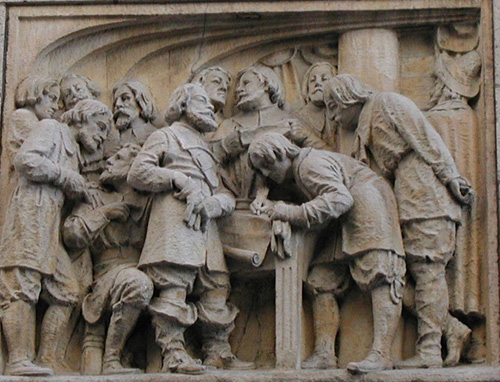 Step 1) The ‘New England Way’ of the Church (1600s)
Step 1) The ‘New England Way’ of the Church (1600s)
Introduction
The theology of the Church of the founders of the Mass Bay Colony was largely a continuation of that of the Protestant Reformation. The congregational form of church structure and governance, however, under ‘covenantal theology,’ was a new departure in church organization.
The hierarchical (‘top down’) authority of the Church of England was inverted into a unique congregational (‘bottom up’) polity of lay authority, by which Church officers — Elders, Deacons and Messengers — were selected and voted into office by the members of the Church. Proponents of the ‘New England Way’ considered themselves the ‘true’ church, with the avowed purpose of completing the Reformation. The desire for the freedom to create their own church spurred freedom of religious thought, of theological search, and of the practice of this new church polity. This ‘New England Way’ spread across the land and through time.
Covenant Theology
While at this time and among these people of Massachusetts Bay a traditional theological uniformity could be taken for granted, a covenant authorized a community to become a church or congregation. Without the covenant, a church is not a rightful religious body. The covenant gives form to a ‘particular church.’ It provides an ‘orderly knitting together’ for the volunteer association of like-minded believers.
The covenant posits no creedal tests. Members may expect care and concern for their well being, but they are equally obligated to express care and concern for others. The Covenant records the obligation, and this creates a mutual sense of commitment. In orthodox congregations, creedal covenants expressed belief, the congregational covenant proclaimed ‘we unite...’
Covenant theology was not that of strict Calvinism. Calvin’s God was all-powerful, addressing a human nature that was in a state of total depravity. Humanity possessed only a powerless will. God had ‘pre-elected’ certain individuals to a ‘state of grace.’
John Cotton was the principle published formulator and advocate of the ‘New England Way.’ The religious objective of the Mass Bay Colonists was to live a blameless life as ‘Visible Saints.’ By this, they would gain salvation [eternal life] as their heavenly reward. They would live in the ‘Kingdom of God’ for ‘eternity.’
As with the common thrust of the Reformation, the strength of the ‘New England Way’ was fed by belief in the authority of scripture [sola scriptura], and in the example of the ‘primitive church’ of Jesus and his disciples. The colonists created a simple service at a Sabbath Gathering. Reliance was based on a heavenly rather than an earthly king. These people had found corruption on the highest levels of the state church, but they did not separate for it. The Mass Bay Colonists were nonconformists, intent on ‘purifying the church from within.’ In successive decades, the Church was to move onward, to seek a benevolent God, and a humankind endowed with free will, living in dignity.
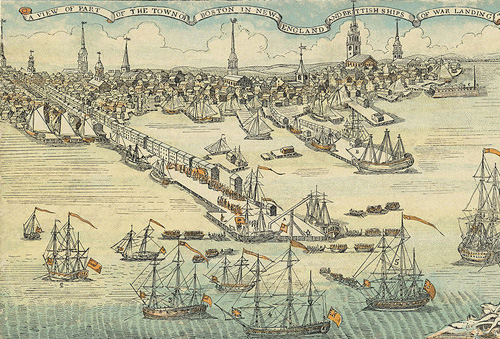 Step 2) Rational Theology (1700s)
Step 2) Rational Theology (1700s)
Faith and Reason
Introduction
During the early 1700s, the original impetus of the congregational movement had become codified and passive. As the initial tests for Church membership waned, relaxed practices enveloped the congregations.
In the 1740s, a native impulse to reenergize ‘old-time’ Calvinist religion, a ‘Great Awakening’ erupted from the countryside. A highly emotional religious experience, ‘awakenings’ were carried on by traveling evangelists, emphasizing conversion into a ‘new person,’ the New Birth of a ‘born again’ individual.
The effect on the Standing Order of the established congregational churches of New England was, in many ways, very severe. The revivals weakened the normal parish system and diminished the prestige of established ministers. The itinerants proclaimed that they were called by God to do his work wherever it needed to be done, with visions, tumults and disorders commonplace in public worship. No sense of the presence of sin was evident without a show of ‘swooning away and falling to the Ground, where Persons have lain, for a Time, speechless and motionless; [with] bitter Shriekings and Screamings; Convulsion-like Tremblings and Agitations, Strugglings and Tumblings.’ [Charles Chauncy: ‘SeasonableThoughts.’]
Chauncy came to the defense of the churches of the Standing Order, those originally founded by the Colonists. ‘If one Pastor neglect his own People to take Care of others...why not another...’till there is no such Thing as Church Order in the Land?’ Chauncy spoke of these special messengers as ‘Men of all Occupations...who have no Learning and...small Capacities... who imagine they are able...without Study...to speak to the spiritual Profit of such as are willing to hear them.’
Chauncy declared that one ‘ought not to expect immediate inspiration, nor depend upon the assistance of heaven, but rather make diligent study.’ For those following the latter course, ‘if you have indeed been renewed in the spirit of your minds, it will shew it self in your lives.’ Efforts for conversion must come from within. The colonists of religious persuasion faced a choice of theological regression, or a deeper commitment to a more enlightened, rational and liberal outlook.
After decades of preaching and in his lifelong rational study of the Bible, Chauncy published ‘The Mystery Hid from Ages and Generations,’ a conception of universal salvation, the possibility of eternal life for every person. In this theology, God became a Deity who embodied ‘the perfection of wisdom and goodness, of justice and mercy.’ One by one, the Calvinist doctrines — Original Sin, the Trinity, the freedom of the will, among others — were subjected to this searching critique.
Progression
The United States came into being formed around a Constitution. The First Church created a Declaration of Faith, an updated covenant, a document built around belief in universal salvation: ‘We whose names are hereunder written, united by the ties of One Lord, one common Faith, and one Baptism...promise to live in Christian love; to watch over each other as members of the same body; to counsel and assist, whenever there shall be occasion; to be faithful to each other, waiting in joyful hope of an eternal happy intercourse in the heavenly world.’
The Declaration of Faith held that Jesus was sent to ‘redeem us from all iniquity; and purify to himself a peculiar people zealous of good works. We believe in that gospel, and solemnly promise to make it the only rule of our faith and practice.’
These articles illustrate a liberal progression away from New England Puritanism. They represent the end product of such burning issues as the tests within covenant theology, of visible saints, the conversion experience and the nature of true virtue and spiritual relations. With the end of the ‘total depravity’ of Calvinism, the Declaration reflects the triumph of the Enlightenment and the decline of Puritan piety. With a rational study of the Bible, human beings are seen to have the free will to choose good or evil, to overcome original sin. These are the views which anticipate Unitarianism.
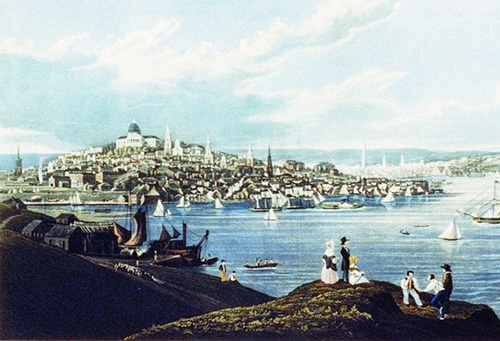 Step 3) Toward the Unitarian Way (1800s)
Step 3) Toward the Unitarian Way (1800s)
Creating the ‘Boston Religion’
Overview
Chauncy’s systematic theology, based on learning, reason and order, had prevailed over the intuition, passion, and disorder found in the Great Awakening revivals. By the 1800s, liberal clergymen broke away from more basic Christian teachings. Two of these departures could be traced to Jacobus Arminius, a 17th century Dutch theologian who had countered Calvin’s doctrine of predestination. Arminius also asserted the compatibility of divine sovereignty with human freedom.
Rejecting Calvinistic patterns of thought, the Boston Arminians developed a new set of basic positions relating to human nature, practical duty and human destiny. Among them were the assertions that ‘all are God’s children, and have the capacity for knowledge of God; that the Bible serves to strengthen and clarify reason, presenting humanity with the moral obligation of justifying God’s existence; and that human beings must emulate the quality of God’s perfection.’
These stances further signified human ability to make moral distinctions, and to act on that knowledge. It was believed that the importance of personal conscience lay in this progressive and increasing capacity in human nature. The religious life became characterized as one of moral progress.
The Arminians also maintained the ‘heresy of Arius,’ that God had, indeed, created a son, but that the son was neither equal to, nor eternal with the father. The name Unitarian typically implies a rejection of the orthodox Trinitarian doctrine. Whatever the sense of Jesus’ divinity, to Unitarians, the equality of Father and Son compromised the full humanity of Jesus. Far more important to them was the urge to foster moral living, and to reject total depravity or ‘eternal damnation.’ But as in the early days of the Colony, these divergences were not contained in doctrines, the rejection of traditional dogma existed in sermons and writings, the ‘ways’ of Boston’s liberal clergy.
Two Approaches to a Unitarian Theology
William Ellery Channing of Arlington Street Church believed that ‘God has given us a rational nature.’ His sermon, ‘Unitarian Christianity,’ given at the ordination of Jared Sparks in Baltimore in 1819, brought controversy to a head. Channing preached a ‘human likeness to God’ as the ‘Divinity within us;’ that our ‘intellectual growth and spiritual regeneration [rebirth] have a metaphorical likeness.’ The defense of human dignity was at the core of his theology. The Unitarian ‘message’ was being formed.
Nathaniel Langdon Frothingham of First Church (1818-50), a scholar, poet, translator of German classics, preached a more conservative Unitarian theology, a ‘quieter’ progression of theological change. Frothingham’s Unitarian theories of salvation had mostly to do with character formation, and his Biblical studies included the statement, ‘we have never pretended to understand all mysteries.’
While marked by a liberal theology, First Church was otherwise conservative, gathering on Sundays for ‘Social Worship.’ At the formation of the American Unitarian Association in 1825, First Church stayed apart. While the term ‘Liberal Christian’ was acceptable, Frothingham never used the term ‘Unitarian’ in the pulpit.
The Unitarian/Congregational Controversy Results in Breakups
At this point, the differing liberal and the orthodox views came into public display. Theological controversies caused a separation of loyalties within the churches. Congregations became divided over traditional doctrines and progressive choices. The separation of the sides placed the — controversy in the courts. Which body of the congregation would retain the church building and its holdings?
The case in Dedham, in 1820, brought the matter into prominence. It was the first contest of record. Which side would become the legal owner of the church building and the church properties? In the event of a ‘schism,’ the court held that the original parish members remaining under the church covenant would receive the property. The other side was rewarded the finances, the silver and the records. The latter were known to express their sense of injustice with the phrase: ‘They kept the furniture, but we kept the faith.’
A Further Journey — Transcendentalism
In the third year of his ministry at the Second Church, Ralph Waldo Emerson resigned his pulpit due to a negative vote of his Congregation. His proposal to them had been to celebrate Jesus’ Last Supper as a memorial service rather than the literal receiving of the communion bread and wine.
Returning from a wide-ranging trip abroad, Emerson found an extension of the pulpit in the lecture platform. Beginning as a poet and writer, one of his earliest ventures resulted in the Transcendentalist journal, the Dial. Margaret Fuller, co-editor, became the periodical’s writer on American feminism.
In his ‘Divinity School Address’ of 1838, Emerson had commended ‘religious sentiment,’ but he asserted that this feeling had lost its grasp in public worship. ‘Tradition characterizes the preaching of this country: it comes out of the memory, and not out of the soul. It aims at what is usual, and not what is necessary and eternal.’ He said the ‘miracles of the Bible are not one with the blowing clover and falling rain.’ He contended that ‘one reverences the person of Jesus rather than his principles. The soul knows no person.’
‘People are not dependent upon miracles, nor upon Jesus, nor upon the Bible for knowledge of religious truth. Truth does not come from outside, but arises spontaneously from within. God reveals vital personal experiences to our souls directly. Human beings are religious beings by their own nature.’
In his succeeding leadership of the Transcendentalist movement, Emerson developed a search for the necessary and eternal through Nature and the ‘reality beyond the senses.’ The terms Self-reliance and the Oversoul populate this world of ‘going beyond,’ where the intuitive or spiritual experience is valued over purely empirical experience.
While Emerson’s philosophy may be read as a highly individualistic version of Unitarianism, his ‘argument-making poetry’ and the radical individualism of his message tend to work against the organized church. His positions led to the ‘Free Religion’ movement and to ‘Humanism.’
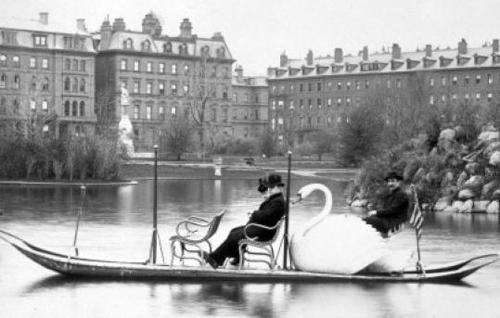 Step 4) The Future and the Past (1860s)
Step 4) The Future and the Past (1860s)
Overview
Inherent in the Unitarian movement was its continuation of the ‘nonconformity’ of First Church’s founders. This ancestral heritage might be paraphrased: ‘to every Puritan (Unitarian), his/her puritanism (unitarianism).’ While orthodox congregational churches were holding fast to traditional values and rejecting liberal trends toward modernism, Unitarians became the faith, for some, of progressivism, and for others, the refuge of quasi-conservatism.
The First Church had a part in the ‘Boston Religion’ of Frothingham’s day. Church records show, however, that in the second half of the century, First Church was not consistently involved with the AUA, nor a regular contributor of funds.
Another Boston minister, James Freeman Clarke, founder of the Church of the Disciples in 1841, propounded new founding principles: the seats were to be free, and the church would be congregation-centered, participating with the minister in worship. The active engagement of members was central to the religious life. This was evidenced by an innovative Sunday School, numbering some 500 children, while the Church housed Fanny Baker Ames’ nationally influential Women’s Alliance, a leading force in social and educational work of the times.
Countering the ‘Five Points of Calvinism’ — Absolute Decrees, Atonement by Christ for the Elect only, Original Sin, Effectual Calling, and the Perseverance of Saints — Clarke’s essentials were: the Fatherhood of God, the Brotherhood of Man, the Leadership of Jesus, Salvation by Character, and the Progress of Mankind.
In the growing, prosperous, ‘elegant Boston’ of the Back Bay, Rufus Ellis planned a ‘Unitarian cathedral.’ Its interior of heavy hammer beams was designed to remind one of Westminster Hall in London, the scene of many seminal theological events. First Church was to be filled with marble and granite plaques to founders, clerics and other members.
In a letter to a parishioner, Rev. Ellis wrote, ‘I wish something might be done to secure [John Cotton’s] pulpit, for a House of Worship built by the First Church should be a memorial building.’ Being notified of this, the Vicar of St. Botolph’s Church replied, ‘If I am informed correctly, the First Church in Boston, of which Cotton was Pastor, has left the faith... and lapsed into [another] form of doctrine...so that, however historically entitled to possess his pulpit, it would be manifestly incongruous to present it to you.’ Vicar Blenkin then closed his message with ‘my best wishes for the welfare of the great people of America.’ Ellis went on to restore the original 1630 Covenant as a membership requirement, and later, to assemble a hymnbook entitled ‘Hymns for the Christian Church.’ [1869]
Chandler Robbins of Second Church, even more conservative, threatened to resign his pulpit if the Church voted to join the National Conference of Unitarian Churches, an effort to organize Unitarian congregations more effectively. Octavius Brooks Frothingham, son of Nathaniel Langdon Frothingham, was a leader in an opposing movement, the Free Religious Association.
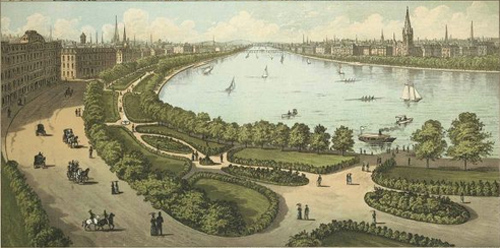 Step 5) Secular & Religious Humanism (1900s)
Step 5) Secular & Religious Humanism (1900s)
Humanists believe that human action and inner growth constitute the religious life, with a central belief in ‘that mysterious, indefinable, but nevertheless intensely real thing, the soul.’
Theistic humanists such as Channing believed that human nature retained a glory because of its connection with God. Channing’s celebrated phrase is that humanity contains a ‘Likeness to God.’
A non dogmatic theism could be based on an understanding of the word God as symbolic of the deepest human needs and strivings. With this theistic perspective, other Humanists would connect with a great and ongoing human tradition. An example would be the movement to reach back to the great minds of the past in order to provide religious elements of personal communion and inspiration.
Amid these currents of modernism and secular humanist tendencies, at First Church, Charles Edwards Park preached a Liberal Christian message based on the teachings rather than the divinity of Jesus. The central quest of Christians was to ‘know Christ in his human character, as a man among men;’ to know Jesus as a teacher whose mysticism was ‘the key to his whole personality.’ Park taught that ‘the core of Christianity was what was in the heart of Jesus, [namely], an intimacy with God.’ From this religious core arose ‘the soul’s imperative to attach itself to other souls so as to form a community. The life of Jesus is the world’s best hope.’
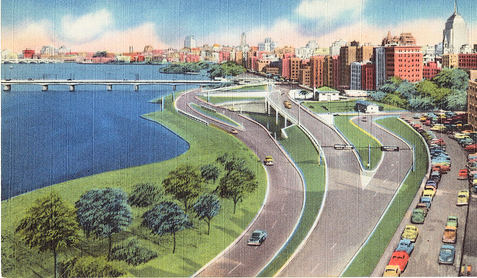 Step 6) Pluralistic Theological Ways (1950s)
Step 6) Pluralistic Theological Ways (1950s)
The growth of lay-led Unitarian Fellowships in the postwar period flourished under Munroe Husbands, director of fellowships for the AUA. He noted that many of the ‘unchurched’ had ‘developed an antipathy toward the entire religious vocabulary: worship, God, prayer, invocation, benediction.’
As the last half of the century brought greater challenge and opportunity, the ministry of Rhys Williams at First Church offered a wide-ranging theology which provided agnostics, atheists, nonwestern and earth centered religionists a sense of inclusion. And in a time of social and political unrest, ‘Williams was the rock.’
In this time of pluralism and diversity, David Robinson put forward a view of the enormous diversity of theological progressions now represented within the Unitarian Universalist movement, including:
1) Christian Liberalism. The Christian tradition viewed in the light of reason and informed by ‘contemporary understandings of myths and symbols.’
2) Deism. The natural order of the physical universe, revealed in science, used as a guide for understanding and action.
3) Mystical Religion. The basis of religion as an experience of mystic oneness with the ‘Divine.’
4) Religious Humanism. The basis of religion as the use of the natural resources of humankind to create a better and more meaningful life.
5) Naturalistic Theism. The process of creativity, ‘only in part controlled by man,’ and operating within the bounds of nature as the basis of religion.
6) Existentialism. The human condition as one of both isolation and radical freedom, with human integrity as the product of decisions made within that context.
Unitarians of numerous persuasions could exist harmoniously in a constellation of theological choices.
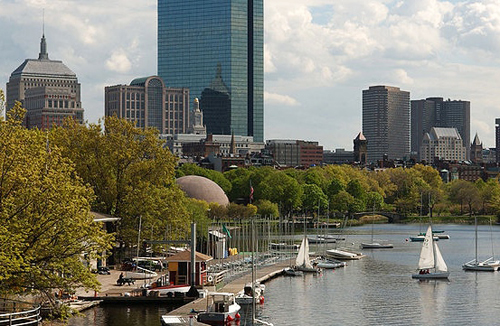 Step 7) The Church Today (2005)
Step 7) The Church Today (2005)
Reverberations
The 375th year of the First Church in Boston is a moment in which to celebrate the past, but as well, a moment to consider the future. This Church was founded on and continues to offer the opportunity for members to experience the religious life in a setting of freedom.
The common thread of First Church theology has been to disentangle from ancient and binding creeds, while, at the same time, to exert the will to unfold, to open and contemplate, with an enlightening reason, the mystical wonder of the universe.
Seventeenth century congregational polity in the twenty-first century is heterarchical. ‘Getting things done’ exists in responsive autonomy. Networking interest groups form as needed.
First Church has been both the creator of and the result of an open and democratic society. As such it is the protector of this society. The voluntary association of its members stems from individual commitment. This Church provides both a means of enacting and of expressing the free choice that creates this open society.
Members of the Church are helped by knowing the rich history and religious beliefs of their Church. This is the foundation on which one can test one’s own beliefs, and by this, ponder and direct what the Church may become.
Epilogue
The godly people of the First Church in Boston, in 1630, took it for granted that everyone in their community was a Christian. Everyone could therefore be admitted to the Church by the simple act of signing the Covenant. To achieve full membership or full communion, however, one had to continue the journey by presenting a conversion narrative, by living a godly life, by acceptance of the community.
Church members of 2005 also take something for granted: that everyone among us has a religious inclination, and is progressive in ones views. And today, the people of First Church continue to sign a covenant, albeit modified for the present day.
Epigrams that purport to define our ‘Unitarianism’ are commonplace: ‘We can believe anything we want.’ ‘Wherever two Unitarians are gathered, there will be three opinions.’ [And each will be hotly contested.]
Is it not time that we define our ‘anythings?’ And that we support, rather than contradict, one another’s’ contributions? Is it not time to turn contest into content — substantive or expressive — so that ‘full membership’ emerges, because we value, rather than compete with one another’s beliefs and actions?
Cannot we, also, as they did in the beginning, ‘bind ourselves in mutuall love and respect, each to other, so neere as God shall give us grace?’
Let this be our Church; so that we may say: This is Our Church.
Sources and further reading:
Richardson (2004), Cooper (1999), Herz (1999), Lambert (1999), Knight (1994), Robinson (1985), Griffin (1980), Winslow (1972), Pierce (1961), Walker (1960), Wright (1955), Wilbur (1953), Allen (1918), Cooke (1902), Mather (1702).